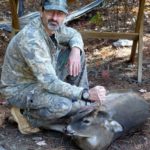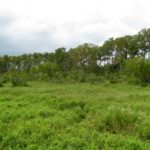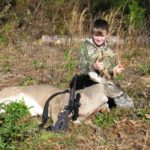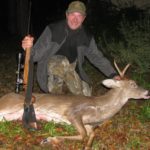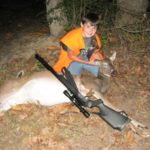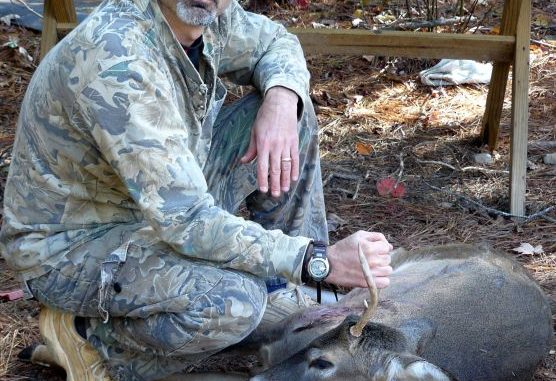
Hunting deer in Bogue Chitto National Wildlife Refuge’s tangled piney woods is a far cry from the storied hunts in the wide-open Midwest, but there’s a simple key that will put meat on the ground nonetheless.
“Now, during most of the day,” my cousin-in-law Al frowned, “the big bucks hole up in this thick stuff. This timber sure makes for tough hunting at times!”
Pelayo and I looked at each other wide-eyed. Pelayo’s lips quivered spastically. His eyebrows danced. The boy was stifling a thunderous guffaw.
Remember on the Carol Burnett Show how Harvey Korman and Burnett always cracked up during skits? Pelayo’s face looked like Burnett’s right before the crack-up.
So I put my finger to my lips, as in: “Behave. Be nice. We’re guests here.”
Which wasn’t easy. I was on the verge of erupting myself. Thing was, we could see for at least a hundred square yards all around us as we noisily shuffled through the dry leaves along the edge of this creek bottom in northwestern Missouri.
Other than over a food plot or down a power line, such visibility where we usually deer hunted was a rare and treasured treat. Staking claim to an acorn-carpeted bottom with such visibility in the hellish pine thickets we normally hunted would require under-the-table bribes. Then the “lucky” member would suffer endless sniping and back-stabbing gossip from all the jealous members he beat to the payoff.
About 100 yards ahead a deer got up, bounded a few feet and then ambled away slowly.
“We’ll probably see much bigger ones,” Al said as what looked like a 4-point melted into the “thickets.”
We were walking an “edge” over what looked like parallel cattle ruts but were actually deer trails. This “edge” consisted of the roughly 30-yard-wide area where a creek bottom of oaks and cottonwoods bordered some northwestern Missouri cornfields — after the harvest.
A person unable to pattern deer movements in such an area should really give it up. He belongs in a box stand/tower in the Texas brush or Hill country where nonsense like “scouting” and “patterning deer” is laughed off as the province of peasants.
A week earlier we’d been scouting a different “edge” much closer to home. There, a finger of cypress-tupelo overflow swamp denoted on some maps as “Devils’ Swamp” edged up against the higher oak and pine bottomlands in the northern Bogue Chitto National Wildlife Refuge.
There the deer sign was much sparser, but the same theme was clearly evident — wherever terrain types met, deer trails appeared.
Pelayo kept chuckling to himself as we walked along the edge of the Missouri cornfield.
“There’s another one,” Al said, pointing.
Sure enough, another rub on a “sapling” whose girth would qualify as camp firewood back home. Walking to it, we noticed a scrape bigger than the last five we saw in Louisiana, combined.
By 8:37 a.m. the following morning, it was over for Pelayo. I heard the shot, and then my phone buzzed.
Half an hour later my shot went off. So I humped down and walked the 300 yards or so down the creek bottom to find Pelayo waving me over excitedly.
“It’s TWUE! — It’s TWUE!” he kept saying, emphasizing the “W” instead of the proper “R,” in the word “true.”
Remember Blazing Saddles? Remember Madeline Kahn as Lili Von Shtupp? Remember her famous line regarding the black Sherriff Bart? Pelayo was imitating her accent.
What Pelayo meant was: “It’s True!” — there are actually places where deer habitat consists of obvious feeding areas, obvious bedding areas, obvious travel corridors. Where deer trails advertise themselves almost with flashing lights that consist of zillions of clearly visible tracks, dozens of rubs, scrapes, piles of droppings, etc.
So you set up an ambush point downwind from a trail intersection in such a place and — “It’s TWUE! It’s TWUE!” — you see a bunch of deer.
But that’s the Midwest. In Louisiana’s piney woods it’s a whole ’nother matter,” to put it mildly. A whole ’nother planet is more like it.
I won’t bore you with any more details of our Midwest hunt. In brief, there’s nothing to them: If you’ve read the national deer-hunting magazines, you know how they go.
In parting, every Dixie deer hunter — and especially every South Louisiana piney woods deer hunter — owes it to himself to make at least one whitetail hunt in our nation’s Midwest, say in the crop country of Missouri, Nebraska, Kansas Minnesota, Illinois, Indiana or Wisconsin. You really, really need to see how “da other half” hunts deer.
It’s a joke. It’s a different sport altogether. You’re hunting on another planet. You’re hunting a different animal — almost a domestic one.
“Who wouldn’t be a serious trophy hunter in those places?” as Artie always snorts.
Al, our Missouri host, is an excruciatingly polite guy. A couple of weeks earlier while on a “work-detail” (actually paaaawtying!) weekend at our camp, we noticed him perusing the “racks” we’d variously nailed up or hung around camp. You could tell Al was exceedingly puzzled if not actually shocked.
“Back home such pathetic ‘racks’ would never be displayed,” you could almost hear him thinking.
Indeed “back home” such “racks” probably didn’t exist! In Midwest farm country a 2 ½-year-old buck is usually a handsome 8-point.
So when we explained that the spindly and misshapen racks we gloated over at our Florida Parishes deer camp belonged to 2 1/2- and even 3 ½-year-old deer, Al freaked.
“And during those 2 or 3 years,” Artie stressed, rubbing it in, “our deer lived under hunting pressure that those Missouri deer can’t imagine, even in their worst nightmares! Ya follow me? So shooting one of our basket-racked little 5-pointers takes more skill (or luck) than waylaying one of those heavy-beamed 8- and 10-pointers you guys shoot! Ya follow me?”
“Heck,” Eddie chimed in, “those big deer on your wall are probably younger than our little ones! And they waltzed through the cornfields and cottonwood creek bottoms, rarely seeing or hearing or smelling a hunter! Ya follow me? Don’t take much to kill one a dem! Ya follow me?”
Al seemed to fully follow both Artie and Eddie, to the point where he excused himself to make a wine run to the local Wag-A-Sack.
Artie and Eddie weren’t very diplomatic about it, but they made excellent points. Heck, comparing hunters like our Apex Predator Josh Chauvin or Ponchatoula’s Ricky Hanno to Midwest farm hunters shouldn’t be legal. Our guys are ambushing some of the wariest deer in America in some of the toughest terrain. Their exploits compare to those of the chump deer hunters in places like Missouri and Illinois like Pike’s Peak compares to Monkey Hill.
But the “edge” pattern for deer trails holds true in almost every place we hunt in Louisiana, and often the terrain change is hardly dramatic.
Often its where, say, a 5-year-old clearcut meets a 15-year-old clearcut. Or where a select-cut area meets an unlogged area or a clearcut area — or a select-cut area that’s older. Where upper pinelands dip down to laurel and willow oak bottoms, we usually find trails. Then, where these oak bottoms give way to cypress-tupelo overflow areas we find more.
Often, however, they’re anything but obvious, what with all the armadillo and raccoon diggings.
In our coastal wetlands, we generally find the trails — not so much on top of the spoil bank itself — as along its inside edge, where the bacchiris, elderberry and willows start giving way to elephant ears and alligator grass.
Hunting our club land was getting tedious. That “fire-in-da-belly” we recalled from our younger years when planning a weekend hunt to some distant WMA just didn’t burn as hotly for the leisurely (and usually fruitless) lease hunts, however gregarious and enjoyable.
So we decided to stay the weekend at Da Camp but actually do the hunting at some of our “youthful” stomping grounds in the Bogue Chitto NWR — and maybe get a little of that fire back, with some of that roadless area’s “wilderness” ambiance.
Flooding from Hurricane Isaac, we also reasoned, probably pushed the deer up the Pearl River basin from the swamps and marshes below.
“Sounds like a plan!” Pelayo said with a thumbs-up, as we disclosed our plan to the clubmates.
Al nodded amiably. But he wanted no part of it.
“If I’m gonna hunt deer,” he always laughs, “I’ll do it on visits back home.”
His golf game has improved dramatically since moving to Louisiana. He’s a regular at Da Camp — for football watching.
And he can’t get enough of our coastal fishing. But as for our deer hunting? Nah.
After hurricanes Katrina, Ike and Isaac (especially the first) Bogue Chitto NWR turned into a ghastly tangle of blowdowns and thickets. Great for the deer (and swine,) needless to say, but tough for us.
The little cypress-tupelo thumb mentioned above stood out like — well — like a sore thumb in the area, offering an oasis of visibility in the desert of thickets. These cypress trees have root systems that defy the strongest winds, so they stay standing and inhibit the growth of understory — plus they’re pretty.
So invariably, my gaze was drawn to the open overflow area (now mostly dry) instead of to the thick border area that contained most of the trails.
Pelayo worked his way into the thickets to put up his climber.
Amazing how the brain works. Deep down I knew he had the better place. Deep down I knew that for every sharp deer track I could see clearly in the mud around my climber, Pelayo probably had 10 mostly invisible (and fresher) ones (and fewer hog wallows) around his slightly higher and brushier ground.
The mud in bottoms captures every deer track and keeps them fresh-looking for days. One advantage is they’re so clear that distinguishing deer tracks from swine tracks is easy. Most deer don’t actually travel in the bottom itself; it’s just that the relatively few times they do they leave such pretty tracks.
Most deer trails run parallel to the bottom but generally a bit on the inside of where the pines or water oaks meet the mushier cypress-tupelo canopy with the swamp iris and smartweed growing below. Such edges abound along the wetland borders of the Pearl, Bogue Chitto, Tchefuncte, Tangipahoa, Amite and most other streams in the Florida Parishes.
The prospect of perching myself in”ugly” thickets with limited visibility like Pelayo demoralized me. In such a place my concentration would wane within an hour instead of the usual two.
And here I’d get a better view of all the whistling woodies at dawn!
Indeed, the birds appeared punctually — just before legal shooting hours. They came in pairs, and then in flocks. A glorious sight — and sound. In the distance I could hear shooting, and soon I was regretting bringing my rifle for deer instead of my shotgun for ducks. Limits (three nowadays, remember) would have been quick and easy.
Deer seemed to be feeding on the tiny willow oak acorns dropping from the trees around my climber. But they also seemed to be browsing on the trumpet creeper, smilax and blackberry in the tropical tangles to my left toward Pelayo’s setup.
By 8:45 a.m., the woodie show was long over, the fidgets had taken over (my elaborate safety harness can only be adjusted and readjusted so many times) and my mind was wandering far from the business at hand.
So I turned toward the thickets — wait a minute! — is that an ear?! A little antler?! An eye appearing just over that carpet of trumpet creeper vines?
Yes! — the ear just flicked! And yes! Antlers! Small, slender ones. A spike, perhaps a 4- or 5-point. The shakes took over. He took a step, and his shoulder cleared the tangles. I s-l-o-w-l-y raised the gun against the tree. (I like to face the tree in a climber) and tried steadying the quivering crosshairs.
“Take a deep breath,” I counseled.” That’s it. No! His ears were up again, and he was looking my way. Then his tail came up.
Then back down! “Whooo. Probably just relieving himself,” I thought. Then he suddenly stopped and lowered his head. Then he raised his nose and seemed to be sniffing the air! His tail flicked! What to do?
The crosshairs were wobbling, and the deer was looking around. “Keep cool,” I thought. A deep breath now, and the crosshairs hovered near his shoulder. Steady now ….
Then he took another step and a tree again obscured his vitals. I was breathing in gasps. I steadied the gun just as he stepped toward a greenbriar thicket. His rib cage cleared a little willow, and his head went down to browse.
The crosshairs were wobbling crazily as my temples throbbed and heart pounded. Another deep breath. The crosshairs finally steadied as I tightened my grip on the rifle. His head came up again. The crosshairs steadied on his shoulder — sq-ue-e-z-e — BA-LAAAM!
The recoil almost knocked me out of the tree. But the deer was still standing! Looking around! I cranked in another round with hands trembling crazily. And again braced against the tree. I was breathing in gasps, but the crosshairs somehow steadied.
PE-TOOAWW!
“Where is? Is he down? Is that a leg kicking? Is that a tail’s final flicking?” Yes!
In seconds the deer was still, and I could see my trophy’s tiny antlers clearly in the scope. I was a basket case. The shakes finally subsided in a half hour, and I started humping it down.
But my smiling and gasping retelling of the episode lasted for hours (days actually). Poor Pelayo probably had it memorized.
Back at Da Camp, the LSU-Arkansas game had everyone riveted to the cable TV. Only Al looked up and rushed over after we pulled up. He was all whoops and smiles and backslaps and high-fives while admiring my trophy.
The boy deserved an Academy Award.
